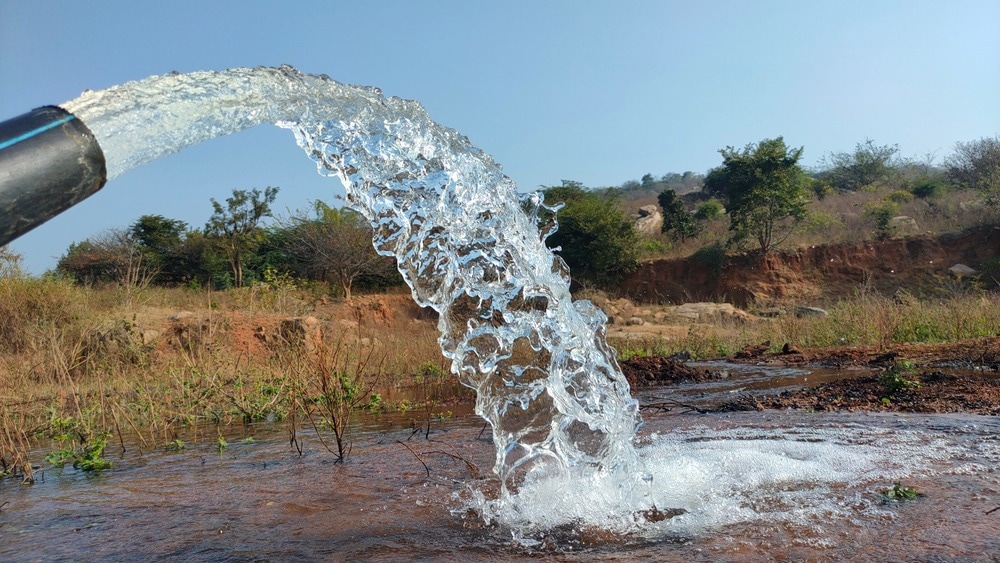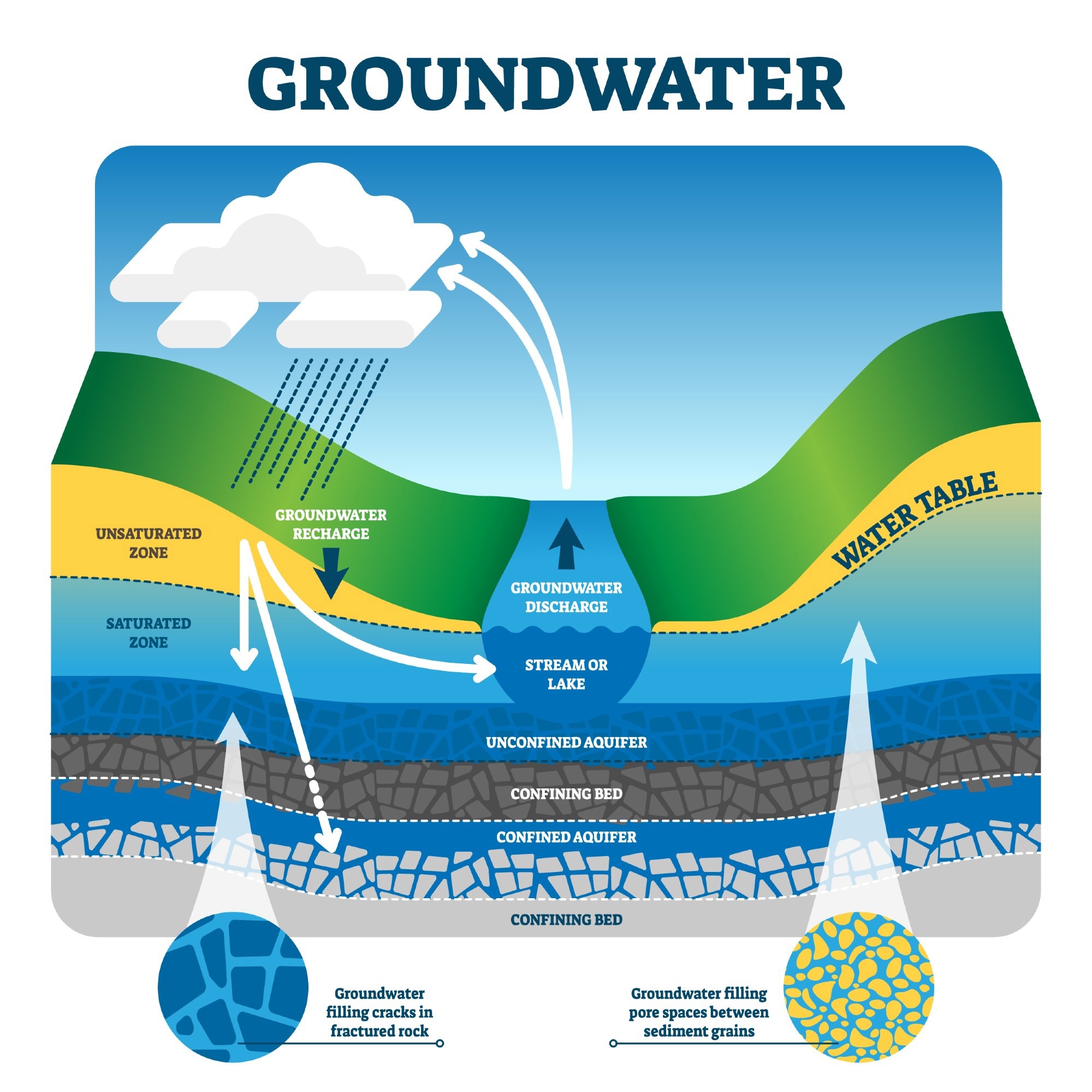In recent years, an increased groundwater abstraction to fulfill increasing residential and irrigation demand has raised concerns about the resource's sustainability. However, with the help of an artificial groundwater recharge system, it is possible to maintain and increase the levels of depleting groundwater resources.

Image Credit: celipuram gopichander/Shutterstock.com
Importance of Groundwater
Groundwater is of paramount importance for humans. It is a major source of fresh water and is actively used in agriculture and various industries.
The thermal energy of groundwater is used to heat buildings and generate electricity, while mineral groundwater is used in medicine for the treatment of several human diseases.
How are Groundwater Resources Recharged?
Groundwater storage is recharged slowly through the water cycle. But with an ever-increasing demand for this resource, an artificial groundwater recharge system can be used to speed up the recharging process.
Natural Groundwater Recharge System
In the natural groundwater recharge system, surface water infiltrates the subsurface, seeps down to the water table through the unsaturated zone, and adds to the groundwater reservoir.

Image Credit: VectorMine/Shutterstock.com
Artificial Groundwater Recharge System
Artificial groundwater recharge is a set of engineering measures to increase groundwater recharge and maintain aquifers' operational reserve.
Groundwater can be artificially replenished by diverting surface water via ponds, infiltration basins, or injecting water directly into the subsurface via injection wells.
Benefits of an Artificial Groundwater Recharge System
Artificial groundwater recharge can alleviate problems related to overexploitation of groundwater. It helps to ensure long-term groundwater management by raising groundwater levels. In many countries, artificial groundwater recharge is being marketed as a solution to water shortages as one of several strategies for managing water resources.
Increased groundwater storage due to artificial recharge allows surface water sources to flow for extended periods, and seasonal streams may acquire perennial flow in some localities.
Using an artificial groundwater recharge system does not necessitate the construction of huge structures such as dams to store enormous amounts of water. It has no negative societal consequences, such as population displacement or the loss of scarce agricultural land. The water stored with an artificial recharge system is immune from natural and man-made disasters.
When artificial recharge methods increase groundwater availability, an increase in vegetative cover will create more soil moisture, which could lead to less soil erosion and a general improvement in flora and fauna, such as an influx of migratory birds and wildlife.
Artificial recharge enhances the maintenance of wetland ecosystems by limiting the entrance of saltwater and storing water for future use. It can also enhance the water quality of saline aquifers, which can then be used for agriculture and cattle farms near the coastline.
An indirect environmental benefit is that as groundwater levels are increased through artificial recharge, less energy will be required to pump the same amount of water. This could result in net savings in energy demands, depending on the recharging method and the energy required by the recharge operation.
Artificial recharge has significantly contributed to aquifer thermal storage for matching cooling and heating demand, which has gained widespread recognition and renewed interest in recent years due to considerable electricity and fossil fuel savings. There will be future research in artificial recharge control for optimizing the energy storage system and increasing its efficiency, particularly for large-scale applications.
Agriculture is frequently related to the special economic benefits of artificial recharging. Commonly cited benefits include the potential for an increase in the total area under irrigation due to greater water availability or an increase in crop yields per hectare due to enhanced land productivity.
In rural areas of developing countries, shallow drilled wells and hand pumps are the major drinking water sources. An artificial recharge system can filter water from these sources and eliminate suspended particles, pathogens and pollutants through physical and biological processes.
Even artificial recharge activities that raise water levels on a localized basis can ensure that such sources operate continuously. The volumes involved in these circumstances may not be huge or constitute a major improvement in net water availability, but they might be significant on a local scale.
Other benefits may include the preservation of water supply in local village wells, which can considerably reduce the time and effort used to collect water for domestic use. This can affect everything from time availability for other productive pursuits to general hygiene and community health levels.
Future Outlook of Groundwater Recharge Systems
Groundwater resources are limited and must be carefully protected from irrational use and pollution. Therefore, at the moment, its protection occupies one of the main places in the system of planetary problems for protecting the natural environment.
Most artificial recharge systems are simple and can be developed and maintained by the communities who benefit directly from them, with little reliance on outside guidance or restraints.
Artificial recharge's effectiveness in many physical and socioeconomic circumstances has received little rigorous examination, and its advantages are frequently anecdotal. Artificial recharge can support lives in a wide range of physical and socioeconomic environments. Therefore, a well-rounded and well-informed viewpoint is required.
Groundwater management approaches that use artificial recharge techniques must first identify criteria that can guide individuals, communities, governments, and non-governmental organizations in determining where artificial recharge is likely to make a meaningful contribution toward solving water problems.
References and Further Reading
Abraham, M., & Mohan, S. (2015). Effectiveness of artificial recharge structures in enhancing groundwater storage: a case study. Indian J Sci Technol, 8(20), 1-10. https://doi.org/10.17485/ijst/2015/v8i20/81596
Bhalerao, Satish A., and Tushar S. Kelkar. Artificial recharge of groundwater: A novel technique for replenishment of an aquifer with water from the land surface. Int. J. Geol. Earth Environ. Sci 3 (2013): 165-183.
Choi, M. R., & Kim, G. B. (2022). Effects of Hybrid-Type Artificial Groundwater Recharge and Underground Barrier in a Small Basin. Water, 14(12), 1849. https://doi.org/10.3390/w14121849
Hartmann, A. (2021). The Hydrology of Groundwater Systems-From Recharge to Discharge. Encyclopedia of Inland Waters (Second Edition) https://doi.org/10.1016/B978-0-12-819166-8.00097-9
Shi, X., Jiang, S., Xu, H., Jiang, F., He, Z., & Wu, J. (2016). The effects of artificial recharge of groundwater on controlling land subsidence and its influence on groundwater quality and aquifer energy storage in Shanghai, China. Environmental Earth Sciences, 75(3), 1-18. https://doi.org/10.1007/s12665-015-5019-x
Veeranna, J., & Jeet, P. (2020). Groundwater Recharges Technology for Water Resource Management: A Case Study. In (Ed.), Groundwater Management and Resources. IntechOpen. https://doi.org/10.5772/intechopen.93946
Disclaimer: The views expressed here are those of the author expressed in their private capacity and do not necessarily represent the views of AZoM.com Limited T/A AZoNetwork the owner and operator of this website. This disclaimer forms part of the Terms and conditions of use of this website.